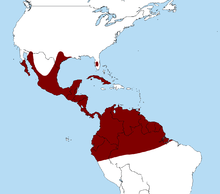Northern caracara
| Northern caracara | |
|---|---|
 |
|
| Northern caracara at Brevard Zoo, Florida | |
| Scientific classification | |
| Kingdom: | Animalia |
| Phylum: | Chordata |
| Class: | Aves |
| Order: | Falconiformes |
| Family: | Falconidae |
| Subfamily: | Polyborinae |
| Genus: | Caracara |
| Species: | C. cheriway |
| Binomial name | |
|
Caracara cheriway (Jacquin, 1784) |
|
 |
|
| Range of C. cheriway | |
| Synonyms | |
|
Polyborus cheriway |
|
Polyborus cheriway
Polyborus plancus
Polyborus plancus cheriway
Caracara plancus cheriway
Polyborus plancus audubonii
Polyborus tharus
The northern crested caracara (Caracara cheriway), also called the northern caracara and crested caracara, is a bird of prey in the family Falconidae. It was formerly considered conspecific with the southern caracara (C. plancus) and the extinct Guadalupe caracara (C. lutosa) as the "crested caracara". It has also been known as the Audubon's caracara. As with its relatives, the northern caracara was formerly placed in the genus Polyborus. Unlike the Falco falcons in the same family, the caracaras are not fast-flying aerial hunters, but are rather sluggish and often scavengers.
The northern caracara is a resident in Cuba, northern South America (south to northern Peru and northern Amazonian Brazil) and most of Central America and Mexico, just reaching the southernmost parts of the United States, including Florida, where it is resident but listed as threatened. There have been reports of the crested caracara as far north as San Francisco, California. and, in 2012, near Crescent City, California. In July 2016 a northern caracara was reported and photographed by numerous people in the upper peninsula of Michigan, just outside of Munising. South of the US border, it is generally common. It can also be found (nesting) in the Southern Caribbean (e.g. Aruba, Curaçao and Bonaire). This is a bird of open and semi-open country.
...
Wikipedia

